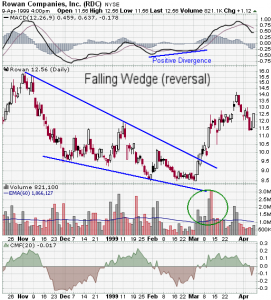a bullish pattern that begins wide at the top and contracts as the prices falls down . This price action forms a cone that slopes down as the reaction highs and reaction lows converge. In contrast to symmetrical triangles, which have no definitive slope and no bias, falling wedges definitely slope down and have a bullish bias. However, until a resistance breakout this bullish bias cannot be realized.
As a continuation pattern, the falling wedge will still slope down, but the slope will be against the prevailing uptrend. As a reversal pattern, the falling wedge slopes down and with the prevailing trend. Regardless of the type (reversal or continuation), falling wedges are regarded as bullish patterns.
1.
Prior Trend: To qualify as a reversal pattern, there must be a prior trend to reverse. Ideally, the falling wedge will form after an extended downtrend and mark the final low. The pattern usually forms over a 3-6 month period and the preceding downtrend should be at least 3 months old.
2.
Upper Resistance Line: It takes at least two reaction highs to form the upper resistance line, ideally three. Each reaction high should be lower than the previous highs.
3.
Lower Support Line: At least two reaction lows are required to form the lower support line. Each reaction low should be lower than the previous lows.
4.
Contraction: The upper resistance line and lower support line converge to form a cone as the pattern matures. The reaction lows still penetrate the previous lows, but this penetration becomes shallower. Shallower lows indicate a decrease in selling pressure and create a lower support line with less negative slope than the upper resistance line.
5.
Resistance Break: Bullish confirmation of the pattern does not come until the resistance line is broken in convincing fashion. It is sometimes prudent to wait for a break above the previous reaction high for further confirmation. Once resistance is broken, there can sometimes be a correction to test the newfound support level.
6.
Volume: While volume is not particularly important on rising wedges, it is an essential ingredient to confirm a falling wedge breakout. Without an expansion of volume, the breakout will lack conviction and be vulnerable to failure.
As with rising wedges, the falling wedge can be one of the most difficult chart patterns to accurately recognize and trade. When lower highs and lower lows form, as in a falling wedge, a security remains in a downtrend. The falling wedge is designed to spot a decrease in downside momentum and alert technicians to a potential trend reversal. Even though selling pressure may be diminishing, demand does not win out until resistance is broken. As with most patterns, it is important to wait for a breakout and combine other aspects of technical analysis to confirm signals.

It’s so lucky for me to find your blog! So shocking and great! Just one suggestion: It will be better and easier to follow if your blog can offer rrs subscription service.
Great articles and it’s so helpful. I want to add your blog into my rrs reader but i can’t find the rrs address. Would you please send your address to my email? Thanks a lot!